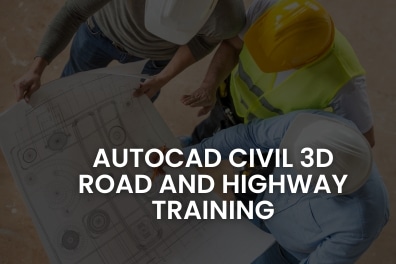Search for your desired courses here
AutoCAD Civil 3D Road and Highway Training in Dubai, Sharjah
Course Overview of AutoCAD Civil 3D Road and Highway:
The AutoCAD Civil 3D Road and Highway course is tailored for civil engineering professionals involved in the design and management of roadways and highway systems. This course delves into advanced features of AutoCAD Civil 3D, focusing on creating detailed road and highway designs, including alignments, profiles, corridors, and grading plans. Participants will learn to effectively utilize Civil 3D tools to analyze transportation projects, ensure compliance with design standards, and produce high-quality construction documentation.Prerequisites:
- Basic knowledge of civil engineering principles, especially related to roadway design.
- Familiarity with AutoCAD or AutoCAD Civil 3D, including basic drafting techniques.
- Knowledge of electrical design principles and standards like NEC and IES is helpful but not required.
Who Can Take This Course:
- Civil Engineers and Transportation Engineers involved in roadway and highway design projects.
- CAD Technicians and Drafters working in civil engineering who wish to enhance their skills in road design using AutoCAD Civil 3D.
- Project Managers overseeing transportation projects requiring detailed design and documentation.
- Students or professionals aiming to specialize in roadway design and analysis using AutoCAD Civil 3D.
Learning Outcomes:
By the end of this course, participants will be able to:- Navigate the AutoCAD Civil 3D interface and customize it for roadway design projects.
- Create and manage horizontal and vertical alignments for roads and highways.
- Design and model corridors that represent road sections, including grading, cross-sections, and superelevation.
- Analyze and design intersections and roundabouts for optimal traffic flow and safety.
- Generate profile views and cross-section views for comprehensive visualization of design elements.
- Create detailed grading plans to manage site development and drainage considerations.
- Use design criteria and standards (e.g., AASHTO) to ensure compliance with roadway design requirements.
- Produce construction drawings, including plan sheets, profiles, and details, using Civil 3D’s drafting tools.
- Conduct earthwork calculations to estimate cut and fill volumes for roadway projects.
- Export design data in various formats (DWG, DXF, PDF) for collaboration and stakeholder presentations.
Course Modules:
Module 1:Introduction to AutoCAD Civil 3D for Roadway Design- Overview of AutoCAD Civil 3D and its applications in roadway design.
- Navigating the Civil 3D interface and customizing workspace settings for road projects.
- Introduction to design standards relevant to roadways (AASHTO, local regulations).
- Creating and managing horizontal alignments for roads and highways.
- Designing vertical alignments, including profiles and elevation adjustments.
- Utilizing alignment tools to optimize roadway geometry.
- Understanding corridor modeling concepts and applications in road design.
- Creating corridor models to represent road sections, including grading and cross sections.
- Implementing superelevation and transition designs for smooth vehicle movement
- Analyzing traffic flow and safety considerations in roadway design.
- Designing intersections and roundabouts, including geometric layouts and traffic control features.
- Utilizing Civil 3D tools for effective visualization and modeling of complex intersections
- Generating profile views for road alignments to visualize elevation changes.
- Creating cross-section views to illustrate road grading and drainage features.
- Annotating profiles and cross-sections with necessary details and specifications.
- Developing detailed grading plans to manage site development and drainage.
- Analyzing drainage patterns and implementing best practices for stormwater management.
- Utilizing grading tools to create and modify surfaces in Civil 3D.
- Applying design criteria and standards (e.g., AASHTO) to ensure roadway compliance.
- Conducting design reviews and analyses to meet safety and functionality requirements.
- Implementing feedback and adjustments based on standard compliance checks.
- Producing detailed construction drawings, including plan sheets and profiles.
- Utilizing drafting tools in Civil 3D to enhance documentation quality and clarity.
- Creating annotation styles and labels for construction drawings.
- Conducting earthwork calculations to estimate cut and fill volumes.
- Utilizing Civil 3D tools to analyze grading and earthwork impacts on the project.
- Generating reports for earthwork quantities and material needs.
- Using data shortcuts and references for effective project management.
- Collaborating with other engineering disciplines (e.g., geotechnical, environmental).
- Exporting design data in various formats (DWG, DXF, PDF) for stakeholder presentations.
FAQs
Q: Is this course specific to AutoCAD Civil 3D?
A: Yes, the course focuses on AutoCAD Civil 3D, specifically for roadway and highway design, utilizing its advanced features for transportation engineering.
Q: Will I learn how to create corridor models for roads?
A: Yes, the course covers the design and modeling of corridor sections, which are crucial for representing the geometric and grading features of roadways.
Q: What certification will I receive after completing this course?
A: You will receive an Autodesk Certificate of Completion, validating your advanced AutoCAD skills.
Q: Do I need prior knowledge of roadway design principles?
A: While a basic understanding of roadway design is helpful, the course will provide comprehensive guidance on utilizing Civil 3D for these applications.
Q: Will I be able to produce construction ready roadway drawings?
A: Yes, by the end of the course, you will be able to generate detailed construction drawings, including road plans, profiles, and cross-sections.
Q: Can I collaborate with other professionals using AutoCAD Civil 3D?
A: Yes, the course emphasizes the use of data shortcuts and references to facilitate collaboration and project management among various stakeholders.





